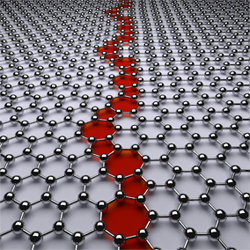
Submitted by Prof. C.J. Pickard on Thu, 06/10/2016 - 15:04
We have developed a general first-principles approach to predict the crystal structure of interfaces in materials, a technique that represents a major step towards computationally developing materials with specially designed interfaces. It is based on the ab initio random structure searching approach (AIRSS): It relies on generating random structures in the vicinity of the interface and followed by relaxation of the structures within the framework of density functional theory.
We have studied grain boundaries in two structurally and chemically very different materials, graphene and strontium titanate, and found new low energy structures for both systems. Both materials are important to the microelectronics industry, but more importantly each also represents a larger class of materials, and a better understanding of the crystal structure and properties of their grain boundaries has the potential to make significant long-term impact in this and other industry sectors.
G Schusteritsch, C J Pickard, "Predicting interface structures: From SrTiO3 to graphene", Physical Review B, 90(3), Article No. 035424 (2014) DOI: 10.1103/PhysRevB.90.035424

